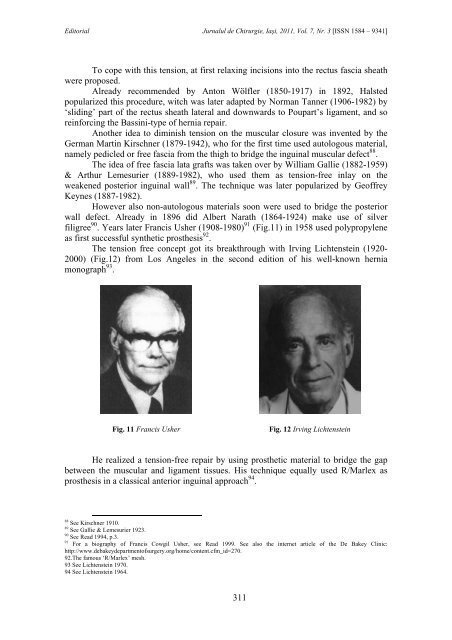PDF (10 MB) - Jurnalul de Chirurgie
PDF (10 MB) - Jurnalul de Chirurgie
PDF (10 MB) - Jurnalul de Chirurgie
You also want an ePaper? Increase the reach of your titles
YUMPU automatically turns print PDFs into web optimized ePapers that Google loves.
Editorial <strong>Jurnalul</strong> <strong>de</strong> <strong>Chirurgie</strong>, Iaşi, 2011, Vol. 7, Nr. 3 [ISSN 1584 – 9341]<br />
To cope with this tension, at first relaxing incisions into the rectus fascia sheath<br />
were proposed.<br />
Already recommen<strong>de</strong>d by Anton Wölfler (1850-1917) in 1892, Halsted<br />
popularized this procedure, witch was later adapted by Norman Tanner (1906-1982) by<br />
‘sliding’ part of the rectus sheath lateral and downwards to Poupart’s ligament, and so<br />
reinforcing the Bassini-type of hernia repair.<br />
Another i<strong>de</strong>a to diminish tension on the muscular closure was invented by the<br />
German Martin Kirschner (1879-1942), who for the first time used autologous material,<br />
namely pedicled or free fascia from the thigh to bridge the inguinal muscular <strong>de</strong>fect 88 .<br />
The i<strong>de</strong>a of free fascia lata grafts was taken over by William Gallie (1882-1959)<br />
& Arthur Lemesurier (1889-1982), who used them as tension-free inlay on the<br />
weakened posterior inguinal wall 89 . The technique was later popularized by Geoffrey<br />
Keynes (1887-1982).<br />
However also non-autologous materials soon were used to bridge the posterior<br />
wall <strong>de</strong>fect. Already in 1896 did Albert Narath (1864-1924) make use of silver<br />
filigree 90 . Years later Francis Usher (1908-1980) 91 (Fig.11) in 1958 used polypropylene<br />
as first successful synthetic prosthesis 92 .<br />
The tension free concept got its breakthrough with Irving Lichtenstein (1920-<br />
2000) (Fig.12) from Los Angeles in the second edition of his well-known hernia<br />
monograph 93 .<br />
Fig. 11 Francis Usher<br />
Fig. 12 Irving Lichtenstein<br />
He realized a tension-free repair by using prosthetic material to bridge the gap<br />
between the muscular and ligament tissues. His technique equally used R/Marlex as<br />
prosthesis in a classical anterior inguinal approach 94 .<br />
88 See Kirschner 19<strong>10</strong>.<br />
89 See Gallie & Lemesurier 1923.<br />
90 See Read 1994, p.3.<br />
91<br />
For a biography of Francis Cowgil Usher, see Read 1999. See also the internet article of the De Bakey Clinic:<br />
http://www.<strong>de</strong>bakey<strong>de</strong>partmentofsurgery.org/home/content.cfm_id=270.<br />
92.The famous ‘R/Marlex’ mesh.<br />
93 See Lichtenstein 1970.<br />
94 See Lichtenstein 1964.<br />
311

















